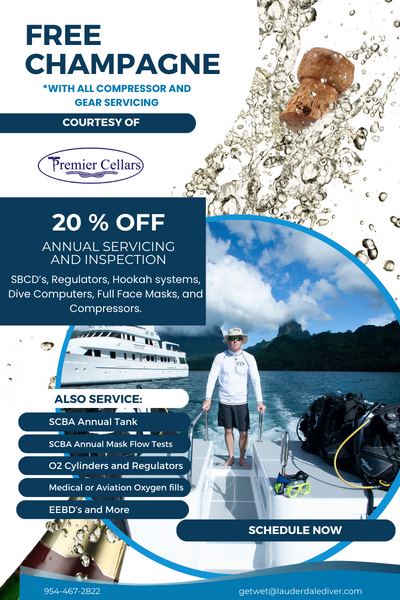Tahiti Dive Guide

IA ORA NA E MAEVA I TAHITI (1)
Although we have been living in this country for eight years, it is always magical to travel and discover new islands out of the 118 scattered on a territory as large as Western Europe. Not surprisingly, a boat is the ideal way to travel around Tahiti and her islands. French Polynesia is a fabulous place for nature lovers both on land and under the water. Providing our services as live aboard dive guides on megayachts, here is one of our stories…
The cruise was scheduled in September for a couple of weeks aboard M/V Bullish with Captain Gordon Scott, travelling through the Society Islands and some of the Tuamotu atolls, North East. The charter guests were both interested in diving and visiting unspoiled areas.
Our first stop was Moorea, Tahiti’s sister island, only 10 miles from Tahiti. Arriving in Moorea is very special. Opunohu Bay has been protected from any building construction and offers the greatest scenic view with high sharp mountains and lush green rainforest. Going through the pass to anchor in the middle of the bay brings you back to 1769 when Captain Cook arrived there aboard the Endeavour after having sailed the oceans for months. You can imagine the traditional outriggers approaching the ship laden with singing tanned Tahitians paddling and greeting white men for the first time in their history, after having been totally isolated for centuries.
We got ready for our first shark dive in the ocean with the guests to see the 3- to 4-metre-long lemon sharks swimming on the bottom outside of the pass. The dive spots are usually between 50 and 100 feet deep, and when in the ocean, always very close to the reef. Tahiti is so isolated from any mainland that fish aggregate around the islands like an oasis in the desert. The dive guide, Rodolphe, explained that sharks were protected and that we were likely to see up to 10 different species of sharks throughout the trip. It was very thrilling and yet we didn’t know just what was about to happen…
Getting back to the tender, Rodolphe spotted a humpback with her calf in the distance. We couldn’t believe it and got really excited. As a licenced operator, he gave the pilot very strict instructions on how to approach the whales carefully and explained that if they were resting, we could consider snorkelling with them. We waited a few hundred feet away, while listening to Rodolphe telling us that this was our chance to live a once in a lifetime experience. We put on our snorkelling gear and slowly went in the water. The most magnificent scene was before our eyes. The calf was cuddling his mother, resting. Then he slowly started rising to the surface to breathe and came so close to each of us, definitely watching us, that we were all breathless with emotion. The show went on for a while and we were all speechless going back to the tender!
Overwhelmingly, when we ask crew what is their ideal cruising destination, the response is ‘Anywhere, as long as it’s in the Pacific.’ And no wonder, as this region holds some of the most spectacular cruising, and more specifically diving grounds, of anywhere in the world. Follow us on this magical, breathtaking voyage.



Well, this was quite the start of a cruise with Bullish! Our next stop was Bora Bora, where we sailed overnight passing the islands of Huahine and Raiatea and Tahaa. We did a couple of great dives encountering black tip and grey sharks and eagle ray along with many other fish. At dusk, we went to a very special spot in the lagoon – at the dock of Hotel Bora Bora, where manta rays come to feed thanks to the lights in the water, which by chance attract plankton. We stayed still in the water, mask and snorkel on, enjoying the beautiful ballet of these amazing fish for over an hour. To most people in our group, this was the first time they had seen these animals so close. A wonderful barbecue dinner had been prepared for us on a private motu (2) with a colourful traditional dance show. It felt a bit like we were having a special party with Christian Fletcher and the crew of the Bounty.
After a 17-hour sail to Rangiroa, in the Tuamotu archipelago, we were greeted by huge bottle-nose dolphins swimming alongside Bullish in Tiputa pass. We anchored close to the pass in the lagoon. Nicknamed the diving mecca by dive aficionados, Rangiroa is the second largest atoll in the world. During our dive, not only were we lucky enough to dive with sharks (we also saw a great hammerhead in the distance), but we were also surrounded by a dozen dolphins all around us while drifting through the pass. The dolphins are year-round residents and like to come and greet the divers. The visibility is always excellent in French Polynesia. A pass can be rough with the various currents and it made the guests realise how important it was to dive with an experienced guide. We spent our last day at the blue lagoon (a small lagoon within the lagoon) enjoying a Tahitian picnic on a coral white sand beach shaded by coconut trees and aito (3) with a light blowing tropical sea breeze. Meanwhile, the Chef was getting some more provisioning thanks to one of the daily flights from Papeete. Indeed, the atolls are definitely a fairly bad place for shopping addicts!
On the way to Fakarava, we stopped on the unspoiled atoll of Toau. Excellent dives and in the evening, Rodolphe took us to a secret place where we set traps with fresh coconuts cut open to attract the shy but incredible coconut crabs (they can weigh up to 20 pounds). Having no predators, some birds had nested on the ground and the chicks were looking at us out of curiosity. After dinner, we went back ashore, in the bush with torches and saw lots of small hermit crabs and huge blue coconut crabs. They live on land and feed on coconut flesh only. We felt like castaways on a tiny piece of land in the middle of the Pacific Ocean. Being an endangered species, naturally we released all of them.
Our last destination was Fakarava. Captain Gordon anchored close to the small airport near the North pass. Fakarava and the surrounding atolls are a UNESCO classified biosphere. Diving the pass in the incoming current was tremendous. We passed close to grey sharks, schools of barracudas, then went down to Ali Baba’s canyon, which was sheltered from the current, and enjoyed watching the fish swim by above us.
However, our best time in the water was in the South Pass (depending on the boat’s draught, it is possible to cruise down the lagoon from the North.) The place is completely cut off from the rest of the world, with only a handful of inhabitants. The pass is narrow and shelters hundreds of grey sharks. We found all kinds of beautiful tropical fish when snorkelling in the lagoon, including huge friendly Napoleon wrasses and cute turtles feeding on small sponges stuck on coral pieces. Some of the guests also went surfing as the swell was good, while the others went to a pearl farm to discover the art of grafting the mother of pearl oysters, which make such exquisite black pearls. On our last day, we took a tender ride to nearby islets offering fabulous light pink beaches due to the colour of the seashells.
This was already the end of a marvellous trip for both crew and guests. On the way to the airport, the guests watched for a last time the unreal crystal-clear water of the lagoon before boarding their airplane. They promised to be back soon to explore further untouched and uninhabited islands. Mauruuru (4) Tahiti! Mauruuru Bullish!
TAHITI FACT FILE
Tahiti and her islands are officially called “French Polynesia”, which has been a French territory since 1842 and the inhabitants hold a French passport. It is a safe country to sail to. French and Tahitian are the official languages but English is understood and spoken in many places.
French Polynesia regards conservation as a priority. Sharks are protected and the country has become a sanctuary for marine mammals in 2002. Although dolphins can be encountered at any time of the year, humpback whales migrate to French Polynesia between July and November, the peak time being September and October. Whale watching in Tahiti requires a fully licenced operator.
Tahiti, the main island, is well developed and is definitely the place for re-fuelling and provisioning. Basically, any food request is possible with great quality products. While in Tahiti, a couple of places to stay with the yachts are the Marina Taina only a few miles from downtown Papeete (the capital city) or the main dock in Papeete. Tahiti Ocean is the most important agent locally and can assist in sorting out customs / immigration (French regulations apply), provisioning, spare parts, etc. The only international airport is Faa’a on the island of Tahiti.
TAHITI GLOSSARY
(1) Hello and Welcome to Tahiti in the Tahitian dialect.
(2) Islet in Tahitian – always located in the lagoon and usually close to the reef.
(3) Local pine tree.
(4) Thank you.








